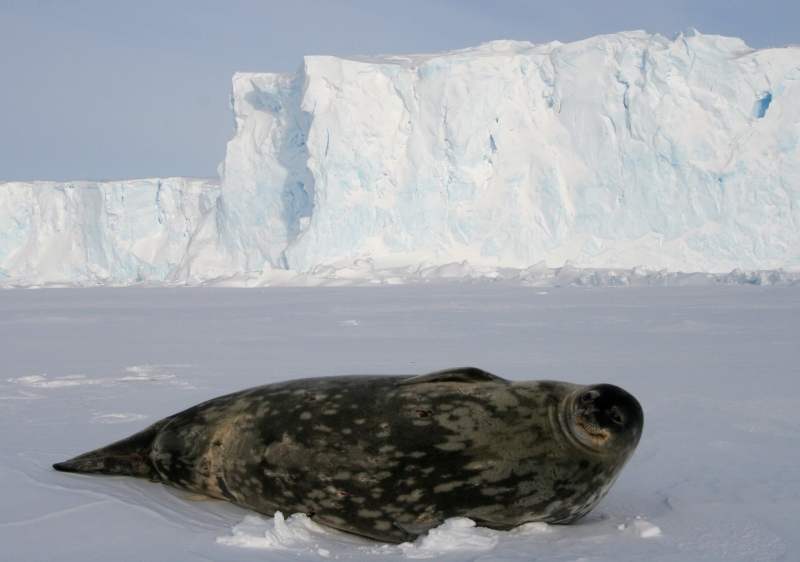One Antarctic animal that I haven't talked about yet is the Weddell Seal. Seals are marine mammals that breath air and live on land, but spend much of their time in the water. The Weddell Seal is a species that lives in and near Antarctica. They live farther south than any other mammal!
[photo credit: Wikimedia]
Because Weddell Seals live in such a cold environment, they have a very thick blubber layer to help keep them warm. They are a bit fatter than most other species of seal, and can weigh up to 1000 pounds! They also have dark fur to help absorb sunlight. Lying on the sea ice in the sun also allows seals to warm themselves. Throughout the day, there are hundreds of Weddell Seals lying around on the ice while we're out working hard in the field!
[photo credit: Wikimedia]

Weddell Seals hunt in the water for fish, squid, and krill (very similar to what penguins eat!). Seals are very well adapted for swimming in the water to hunt. They can dive very deep (up to 700 meters) and hold their breath for over an hour (up to 80 minutes!). Myoglobin in the seal's blood stream helps store oxygen for longer periods of time, allowing them to dive so deep and long. They are also able to collapse their lungs and lower their breathing rates.
Weddell Seals also mate underwater. They give birth to pups in the Antarctic spring, during September to November. Pups reach maturity after 3 years.
However, the water is not always safe for seals. Their main predator in this area are orcas (killer whales), which love to eat seals! When they're not hunting, seals stay on the sea ice, where it's much safer. However, they still have to be careful, because an orca will come by and jump onto the end of a loose piece of sea ice to knock a seal into the water!

Seals aren't as social as penguins. While you'll find penguins in large groups, seals tend to spread out. They scatter across the ice as individuals, rather than hanging out in large groups.
Weddell Seals can live for up to 20 years, which is actually much younger than most other species of seals, which can live for up to 40 years. The reason Weddell seals don't live as long as other seals is that they constantly have to chew away at the ice to give themselves breathing holes, which means their teeth wear out much earlier in life. Without good teeth, they can't eat which means they won't live as long. Sometimes, seals crawl far into the Dry Valleys. Because they are so far from food and the ocean, they die there. Because it's so cold, the bodies don't decay very quickly, and we occasionally find centuries-old mummified seal carcasses while we're doing our field work! I'll spare you the photographs...
Weddell Seals are not the only seals living in Antarctica. There are also leopard seals and elephant seals, but they do not live in this particular area of Antarctica where we work. Elephant seals are much bigger and hunt larger animals, and have even been known to attack humans! The skulls below show you the difference in how the animals are built. The elephant seal on the far right has a bigger hard with much sharper teeth (and a stuffed animal in its mouth) than the Weddell seal skulls on the left. I'm glad I haven't met an elephant seal!





